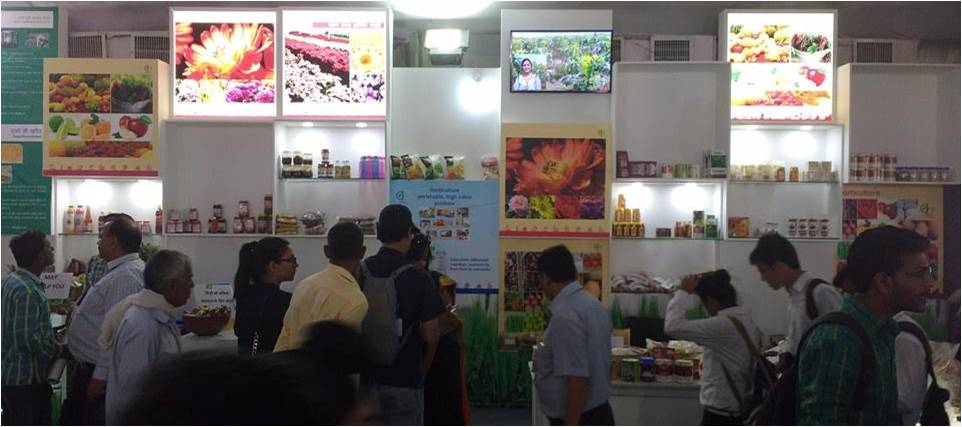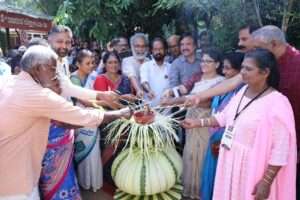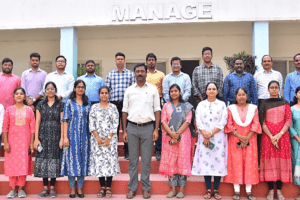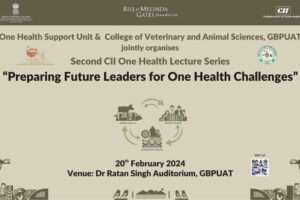Bhagya Vijayan and Laxmipriya Upadhyaya participated in the Krishi Unnati Mela organised at the Indian Agricultural Research Institute, New Delhi and they share their observations here.
INTRODUCTION 
Krishi Vigyan Mela (Agricultural Science Fair) is one among the significant mass contact method of technology transfer which addresses the principle of extension i.e., “seeing is believing”. It offers an opportunity to farmers to witness live demonstrations and interact with scientists so that they could learn from the latest technologies and information. It also benefits scientists, extension personnel and policy makers as they become cognizant of farmers expectations, and their urgent needs.
Krishi Vigyan Mela is an annual event held in all its pomp and fashion luring farmers from various parts of the country. Indian Agricultural Research Institute (IARI), New Delhi, used to organize Pusa Krishi Mela every year to mainly showcase its latest technologies to the farming community. But this year, its scope was enlarged due to the collaboration from the Ministry of Agriculture and Farmers Welfare (MOA&FW) and Confederation of Indian Industry (CII).

©Mahesh Chander
The mela was inaugurated on 19 March 2016 by the Honourable Prime Minister of India, Shri Narendra Modi. In his exemplary inaugural speech, the Prime Minister emphasized on the benefits of organic farming and the importance of scientist-farmer interaction in technology development. He launched a mobile app called “Kissan Suvidha” that could provide agricultural information at the right time at the right place to the right person. He stressed on the potentiality of new pro-farmer initiatives like Fasal Bheema Yojana, Krishi Sinchai Yojana, Mera Gaav Mera Gaurav, Gokul Mission, Soil Health Card Scheme etc. To support farmers, much more programmes are on the anvil, he clarified. He assured the farmers that all possible efforts are crafted to double the income of farmers by 2022. Krishi Karman award for 2016 was also presented by him to farmers of various states for their achievements in production of cereals, pulses, oilseeds etc.

MAJOR ATTRACTIONS
The major attractions of Krishi Unnati mela were as follows:
- Thematic pavilion: This pavilion focused on specific topics was one of the major attractions at the Mela. The pavilion had eight zones viz. agro-climatic variety in India; water as an input to agriculture; Soil Health; Pro-farmer schemes of MOA&FM; Animal Husbandry and Fisheries; Agri-rejuvenation; Agri-Technology; and Horticulture.
- Stalls showcasing novel products: Nearly 500 stalls with good space management were on display. Various research institutes, self-help groups, agri-entrepreneurs, voluntary organizations and other stakeholders exhibited their innovative products. The stalls were attractive as they displayed the innovative technologies and novel agro-products. The budding agri-entrepreneurs (practicing organic farming, apiculture and mushroom cultivation) and manufacturers of agri-engineering equipment had an opportune moment to showcase their products. There was a high demand for seeds of varieties developed by IARI.
- Live demonstrations: Integrated Farming System (IFS) demonstration was a major attraction at the Krishi Unnati Mela. It was an eye opener to the farmers as it portrayed the benefits of integrating agriculture, livestock and dairy. Farmers were curious enough to collect information on the same as one could see them thronging the site. Practice of IFS ensured farmers income from multiple sources as well as a credible method to overcome climate vagaries and dangers from monoculture. Scientists explained the procedures to establish IFS, costs incurred and advantages. This time mela had also witnessed livestock exhibition, where the largest crowd puller was Yuvraj, a bull famous for its semen quality.
- Experience sharing by farmers: Innovative farmers shared their experiences and motivated the farmers assembled in the mela. The patented innovations explicitly revealed the brilliance of the farmers. Such indigenous innovations often proclaim the worth of our farmers.
-
- Crowd Management: Crowd management is one of the most important and tedious part of any large scale programmes especially when there are presence of VIPs like Prime Minister and other Union Ministers. Registration counters were arranged on the way to the mela ground, little away from the entrance of the ground, but in required number at different spots. Help desk counters were arranged at the entrance of the institutes. Albeit these efforts, some farmers complained of getting lost in the Mela ground. But all possible efforts were extended by the IARI student volunteers and the scientists.Other facilities: There were facilities like food court and portable drinking water. Special care was taken to ensure proper maintenance and cleanliness.Cultural events: The mela gave an opportunity for folk artists to exhibit their talents. Some of the participating farmers also participated by reciting poems and patriotic songs in the cultural events organized in the eveningWebcasting of programme: Timely telecasts and upload of the videos covering snippets of Krishi Unnati mela were carried out. The organizers also ensured coverage of the mela by Television channels. Many farmers were interviewed by the media representatives.Box 1: Session on Agricultural Extension: Farmer Scientist Interaction (10 AM to 1.30 PM, 20/03/2016) One of the technical sessions of this Mela was devoted to discuss issues concerned with extension services including ICT interventions, agrarian challenges, National Mission on Agricultural Extension & Technology etc which was chaired by Dr A K Singh, Deputy Director General (Agricultural Extension), ICAR. After the brief introductory remarks by Dr A K Singh, the session had addresses from Dr V V Sadamate (Former Advisor, Planning Commission); Dr B S Hansra (Former, ADG (Agril Extension, ICAR); Dr Y R Meena, Additional Commissioner (Extension), GOI; and Dr K V Prabhu, Joint Director (Research), IARI. All of them mainly spoke on various government schemes for the benefit of the farmers and farming in general, appealing farmers to make best use of these schemes to maximize returns from farming enterprise.
-
-
- The famers, however, were more concerned with problems like non-availability of seeds of promising or recommended varieties, non-availability of bio-inputs like bio-fertilizers, bio-pesticides, lack of package of practices and market for organic produce, impending and frequent drought, lack of irrigation infrastructure, power supply in rural areas, lack of soil testing facilities etc. The non remunerative prices for farm produce was ©Mahesh Chanderthe major concern of the majority of the farmers present, citing the case of milk which was fetching the same price per liter, water is being sold in cities. The scientists from IARI responded to some of the technical questions related to crops/varieties etc, but most of the queries of the farmers were related to developmental issues to be addressed by the respective state officials who were not present. The DDG (Agricultural Extension) assured some farmers that he would get in touch with the concerned officials to remedy the situation, while advising them to get in touch with KVKs in their respective districts. The session had provision for a panel discussion too on Modern agro-technologies and service delivery approaches, but it turned out to be mostly a question-answer session, due to unending barrage of questions coming from the farmers making it at times a chaotic situation. The angry reactions from some of the farmers were indicative of the acute/nagging problems farmers are facing at the grassroots level.To make such Interactive meetings more impactful:
► Technical sessions like this should be publicized well and circulated in advance. In this case, many visitors were not aware about these technical sessions.
► The presence of experts in other areas like animal sciences, fisheries, agro-forestry etc need to be ensured. This helps in better response to farmers’ queries in diverse areas. (In this case, only a few scientists from IARI were present)
► Apart from scientists, the line department officials from the participating states should also be invited to handle the farmers’ queries.
► It would have been good to invite innovative/progressive farmers to specific sessions to share their experiences.
► Extension scientists and students, at least those present in the fair, should attend such farmer-scientist interactive sessions as it gives practical exposure about the problems of farmers in different agro-climatic zones.
Based on my experience of attending two mega Farmers’ Fairs in the last two years (Krishi Vasant-2014 at Nagpur and Krishi Unnati Mela-2016, New Delhi), and also based on my experiences with organizing North Zone Regional Agricultural Fair as its Convener in 2015, I believe that extensionists must gear themselves for playing an advisory role facilitating farmers to evolve as agripreneurs rather than just being information providers. The farmers want holistic solutions to their problems, not only the information on a given scheme!
Source: Notes from Dr Mahesh Chander, Principal Scientist and Head, Division of Extension Education, ICARIndian Veterinary Research Institute, Izatnagar, Uttar Pradesh, India
- The famers, however, were more concerned with problems like non-availability of seeds of promising or recommended varieties, non-availability of bio-inputs like bio-fertilizers, bio-pesticides, lack of package of practices and market for organic produce, impending and frequent drought, lack of irrigation infrastructure, power supply in rural areas, lack of soil testing facilities etc. The non remunerative prices for farm produce was ©Mahesh Chanderthe major concern of the majority of the farmers present, citing the case of milk which was fetching the same price per liter, water is being sold in cities. The scientists from IARI responded to some of the technical questions related to crops/varieties etc, but most of the queries of the farmers were related to developmental issues to be addressed by the respective state officials who were not present. The DDG (Agricultural Extension) assured some farmers that he would get in touch with the concerned officials to remedy the situation, while advising them to get in touch with KVKs in their respective districts. The session had provision for a panel discussion too on Modern agro-technologies and service delivery approaches, but it turned out to be mostly a question-answer session, due to unending barrage of questions coming from the farmers making it at times a chaotic situation. The angry reactions from some of the farmers were indicative of the acute/nagging problems farmers are facing at the grassroots level.To make such Interactive meetings more impactful:
- Aesthetics: The cynosure of all eyes was the Make in India logo moulded out in flowers and vegetables. Different floral arrangements and topiary arrangements evinced interest in the visitors to dwell much more inside.
©Mahesh Chander
-
-
CONCLUDING REMARKS
It was perhaps for the first time that the Ministry of Agriculture and Farmers Welfare (MOAFW), Confederation of Indian Industries (CII) and IARI jointly organized a massive mela of this scale at IARI.
These three organizers coordinated the activities efficiently to successfully organize this Mela which was visited by about fifty thousand farmers. This type of Ministry-Research InstitutionIndustry partnership will go a long way in strengthening agricultural development in the country. As the venue was New Delhi, it attracted more of urban farmers and large farmers. Most of the sessions were conducted in Hindi and participants from non-Hindi speaking states demanded literature and discussions in their language. Scientists and students from IARI tried to help them with translations, but that was not enough.
Participants from marginal and small farmers especially from backward districts were very low. So events such as these should also be arranged in all major districts, which will make these events more inclusive participation and thereby reaching the unreached.
Bhagya Vijayan (Email: bhagyavijayan11@gmail.com ) and Laxmipriya Upadhyaya (Email:
laxmipriyaupadhayaya@gmail.com ) are Ph.D and M.Sc Students respectively at the Division of Agricultural Extension, Indian Agricultural Research Institute (IARI), New Delhi, India Technical sessions: Technical sessions on agriculture, livestock, water technology, horticulture, and fisheries were held. The sessions acquainted the farmers with new schemes of government like PM Fasal Bheema Yojana, PM Krishi Sinchai Yojana, National Agricultural Market etc. The sessions were highly informative even had a brief question answer session with experts which gave farmers an opportunity to clarify their doubts. One of the technical session of this Mela was devoted to discuss issues concerned with extension services including ICT interventions, agrarian challenges, National Mission on Agricultural Extension and Technology etc (Box 1)
- Crowd Management: Crowd management is one of the most important and tedious part of any large scale programmes especially when there are presence of VIPs like Prime Minister and other Union Ministers. Registration counters were arranged on the way to the mela ground, little away from the entrance of the ground, but in required number at different spots. Help desk counters were arranged at the entrance of the institutes. Albeit these efforts, some farmers complained of getting lost in the Mela ground. But all possible efforts were extended by the IARI student volunteers and the scientists.Other facilities: There were facilities like food court and portable drinking water. Special care was taken to ensure proper maintenance and cleanliness.Cultural events: The mela gave an opportunity for folk artists to exhibit their talents. Some of the participating farmers also participated by reciting poems and patriotic songs in the cultural events organized in the eveningWebcasting of programme: Timely telecasts and upload of the videos covering snippets of Krishi Unnati mela were carried out. The organizers also ensured coverage of the mela by Television channels. Many farmers were interviewed by the media representatives.Box 1: Session on Agricultural Extension: Farmer Scientist Interaction (10 AM to 1.30 PM, 20/03/2016) One of the technical sessions of this Mela was devoted to discuss issues concerned with extension services including ICT interventions, agrarian challenges, National Mission on Agricultural Extension & Technology etc which was chaired by Dr A K Singh, Deputy Director General (Agricultural Extension), ICAR. After the brief introductory remarks by Dr A K Singh, the session had addresses from Dr V V Sadamate (Former Advisor, Planning Commission); Dr B S Hansra (Former, ADG (Agril Extension, ICAR); Dr Y R Meena, Additional Commissioner (Extension), GOI; and Dr K V Prabhu, Joint Director (Research), IARI. All of them mainly spoke on various government schemes for the benefit of the farmers and farming in general, appealing farmers to make best use of these schemes to maximize returns from farming enterprise.





Happy to see this well written meeting Note reflecting on the Krishi Unnati Mela, which was attended by me too for all three days. The Agricultural Extension Education students thought of writing this is appreciable. Congratulations to Bhagya & Laxmipriya for the excellent effort to pen this Mela.
Thanks Bhagya Vijayan and Laxmipriya Upadhyaya for the brief on Krishi Unnati Mela.
thanks a lot for sharing the information.
The Meeting Note on IARI Krishi Mela is informative and well written. The involvement of MoA&FW and FICCI in the Mela is a welcome change. The participation of PM has added further visibility to the event.